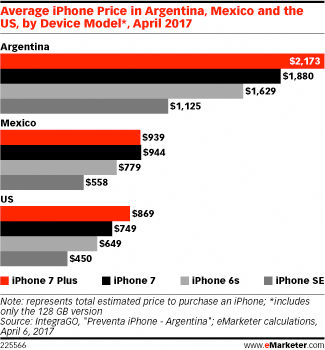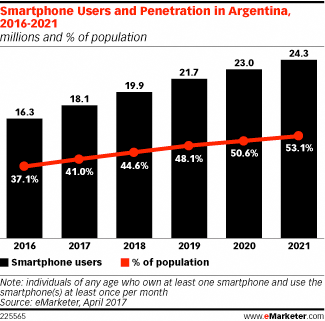In Argentina, an iPhone Costs 150% More than It Does in the US
April 15, 2017
![]() The iPhone has finally arrived in Argentina. But the device is still unaffordable for most people.
The iPhone has finally arrived in Argentina. But the device is still unaffordable for most people.
 Data from IntegraGO, a consulting agency in Argentina specializing in trade marketing, noted that iPhones cost roughly 150% more in Argentina than they do in the US.
Data from IntegraGO, a consulting agency in Argentina specializing in trade marketing, noted that iPhones cost roughly 150% more in Argentina than they do in the US.
The prices start at approximately $1,370 for the 32 GB 6s model and reach upwards of $2,431 for the 256 GB 7 Plus, with prices varying among mobile phone operators and third-party retailers.
In a country where the average salary is only $1,000 a month, most people will find the iPhone out of reach.
“This wave of iPhone adopters in Argentina is predicted to come from the country’s affluent and aspiring middle classes,” said Enrique Carrier, director and founder of Carrier y Asociados.
The iPhone’s debut comes after an eight-year ban on Apple products that were part of former President Cristina Fernández de Kirchner’s protectionist policies geared toward promoting local industry and preventing the flow of dollars out of the country.
During this time, consumer electronics companies had to manufacture products in the remote region of Tierra del Fuego if they wanted their products to be sold throughout Argentina. And the government imposed tariffs of 35% on imports of desktops, laptops and tablets.
Although Samsung and LG complied, Apple decided to leave.
 In short order, a black market formed. As the demand soared, smugglers began taking iPhones, iPads and MacBooks across the border.
In short order, a black market formed. As the demand soared, smugglers began taking iPhones, iPads and MacBooks across the border.
At one point in late 2013, Argentina was deemed to be the most expensive country in which to buy an iPhone: The iPhone 5s was selling for as much as $3,500 on MercadoLibre, Latin America’s most popular ecommerce site.
But in February 2017, under President Mauricio Macri (elected in 2015), import policies changed.
As part of Macri’s ambitious agenda to drive foreign investment in the country, Argentina’s Ministry of Economy and Production announced that the government would eliminate the tariff for computers and tablets.
This has allowed companies such as Apple to begin operating and selling their products within Argentina.
But the tariff for smartphones remains. The import tariff alone is 18%, and that doesn’t include a 21% luxury tax and a 21% value-added tax (VAT). These taxes are charged at different stages of the commercial chain, so it’s not correct to just add them up and say the tax added is 60%.
For now, the effect of the iPhone’s arrival is more of a political ploy showing that the market is opening up, rather than an effort to make the devices available to the populace, said Carrier in a blog post.
For the time being, the iPhone is only affordable for an affluent minority.
Nevertheless, Apple has persevered. With the change in import policy, local news outlets reported that Buenos Aires will be home to Argentina’s first Apple Store, which is expected to open in 2018. Apple has also been in negotiations to open new stores throughout the region in Guadalajara, Monterrey, Santiago and Lima.
The result is that smartphone ownership is rising in Argentina.
eMarketer estimates there will be 18.1 million smartphone users in the country this year, and by 2021, 53.1% of the total population will own a smartphone.
Data from Kantar Worldpanel shows that Android devices have dominated the smartphone sales market in Argentina, holding a 94% market share in December 2016. (In the US, by comparison, Android’s share was 54.4% as of December 2016.)
Officially, iOS accounts for only 3.3% of market share in Argentina. Of course, that does not take the black market into consideration.































